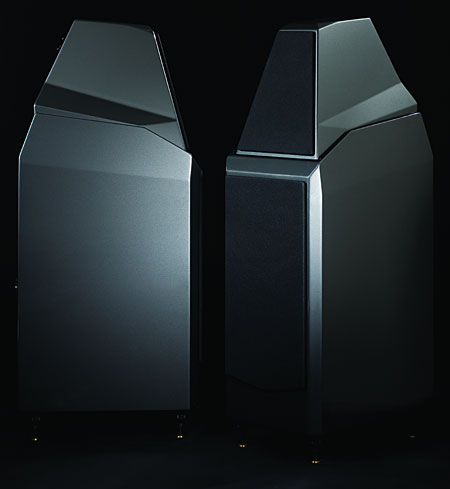| Columns Retired Columns & Blogs |
Hi thanks for review, but it was nice to have a follow up of new Sasha2 by Art Dudley...

The second-order high-pass filter for the midrange driver is set at about 150Hz, which is also the frequency for the woofers' first-order low-pass filter. The woofers, made for Wilson by ScanSpeak, are based on the 8" polymer-cone woofers from the WATT/Puppy 8. But for the Sasha W/P they've doubled up on the magnets, which reportedly yields better acceleration and electrodynamic damping.
As noted on the Wilson website and confirmed to me by David Wilson, the Sasha W/P has an electrical sensitivity of 91dB and is nominally a 4-ohm load, albeit one that drops to 1.8 ohms at 92Hz. Amplifiers of 20Wpc output or higher are recommended—a line I happily toed.
Installation and setup
I was tempted, at first, to suggest that the hardest part of setting up the Sasha W/Ps was getting them off the truck and into my house. But even that wasn't much of a challenge: As I learned when I wrote about the Sophia Series 2 loudspeaker, Wilson Audio works with only a select few freight companies, and their shipping manager oversees the entire process, from loading dock to doorstep.
After opening the three very large wooden crates—one each for the bottom enclosures and a third for the pair of tops—and carefully removing their contents, I had a close look at the various Sasha components. As with other recent Wilson speakers, there was a distinct but indescribable seriousness to the drivers' appearance: the sort of neatness and precision that suggest a level of quality far beyond the reach of the DIY crowd (not to mention many other manufacturers). As with WATT/Puppys of the past, electrical connections between drivers are visible on the enclosures' back panels: Signal leads of fixed length, terminated with gold-plated spade lugs, emerge from the Sashas' lower enclosures, in which the crossover networks are now located. (For as long as the model was called the WATT/Puppy, the woofer module was viewed as an add-on: The crossover remained in the "main" upper-frequency enclosure!) On the back of each bottom enclosure is a single pair of inputs, addressable only with spade lugs, for connection to the amplifier of choice.
Throughout my review samples, the attention to detail was astonishing. All the bolts were nonmagnetic stainless steel. My fly reel wishes it were made as well as the Sashas' machined-alloy reflex ports. Wool and foam baffle pads were shaped and sized with rare precision. The Sashas' paintwork was literally flawless. And the grilles, which are recommended to remain in place during use—another line I toed—actually fit. Think of it.
As with the Sophia Series 2s, and as will happen with literally every new pair of Wilson loudspeakers purchased from an authorized dealer, my review pair was installed and set up by a Wilson-trained technician—in this case, Wilson's own Peter McGrath, whose name will be familiar to most Stereophile readers. Though said setup didn't require the use of a microphone, spectrum analyzer, or other technical hardware, I hesitate to call it subjective, if only because it was so systematic. McGrath listened for very specific things and—with a decidedly low-tech pencil and yellow legal pad—assigned a value to each change he noted. There was an order. There was a hierarchy. There was a system.
The distances from the Sashas to the walls of my 19' by 12' room changed, and changed again. So did the angle of the Sashas' toe-in, and the precisely adjustable angle between the upper and lower enclosures. So did the height of their chunky and smoothly machined floor spikes. To no one's surprise, the Sasha W/Ps wound up very near to where the Sophias had worked best. And though I don't want to get ahead of myself, it must be said that, when Peter McGrath's work was over, I was powerless to prevent myself from staying up way too late, listening to music. McGrath doth murder sleep.
Listening
As I recall, the Wilson Sophia Series 2 required about 10 days' steady use before sounding really great in my home. Similarly, a little more than a week after Peter McGrath installed them in the exact same system—Thorens TD 124 turntable with modern Schopper platter and bearing; EMT 997 tonearm, fitted with various EMT and Ortofon SPU pickup heads; Ayre Acoustics QB-9 USB D/A converter, fed AIFF files from an Apple iMac; Shindo Masseto preamplifier; and Shindo Corton-Charlemagne mono amplifiers, their output-transformer secondaries configured for a 4-ohm load—the Sashas became sonically and musically unignorable. Leonard Cohen's Live in London (CD/AIFF, Columbia 88697405022) suddenly took on the physical and emotional presence I'd heard through the Sophias at their best. And in the Kyrie of Beethoven's Missa Solemnis, with Otto Klemperer and the New Philharmonia Orchestra and Chorus (LP, Angel SB-3679), the voices of Elisabeth Söderström and Martti Talvela were freed from the flatness of storage to glide, realistically, over the orchestral storm.